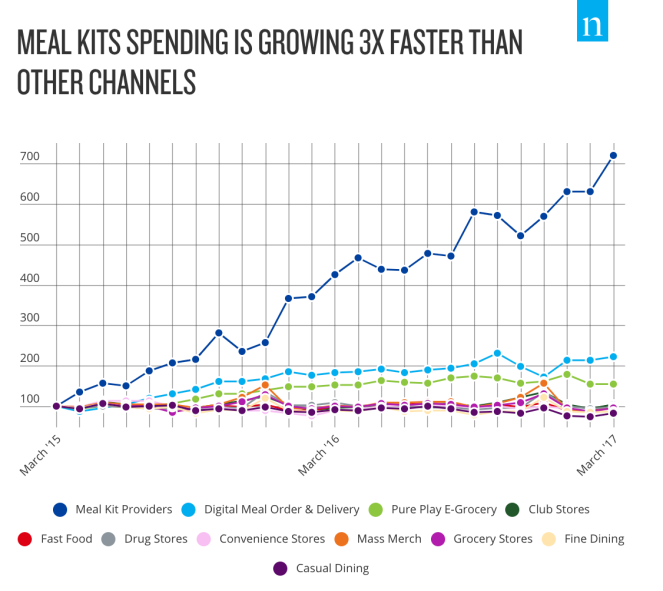Consumer attitudes towards meal-time are transforming. Cooking is being viewed as a social activity, bringing about family time and enjoyment. According to Solomon and Russell-Bennett, an attitude is a learned predisposition, whereby one behaves in a consistently favourable or unfavourable manner with respect to a given object (2019). For HelloFresh, it is imperative their consumers have a favourable attitude towards their product/service; this will result in increased satisfaction, open up opportunities for positive word of mouth and long term retention.
Claire Davenport, HelloFresh’s UK CEO, states that as a result of consumers positive attitudes towards this service, “The meal kit delivery market has become increasingly crowded…indicating the rising interest and success of online models in the food market” (Askew 2017). As a result, HelloFresh focuses their business model on investing in their consumers daily routines and preferences. It is also through their “unique procurement setup” that the company aims to create positive attitudes towards the brand (Askew 2017).

Firstly, a consumer’s attitude can be formed through; their family and friends, direct personal experience, direct marketing, mass media or the internet (Solomon and Russell-Bennett 2019). For an average HelloFresh consumer, one may assume they may experience all five influences on attitude formation.
- Family and Friends – If a consumers family/ friend has recently purchased HelloFresh and are impressed, for example, with the time it took to make the meal, the quality of ingredients and ease of use, this may impact favourably on their attitude towards the brand. For example, a sales promotion tool HelloFresh implements is the ‘Refer a Friend Program’.
- Direct Personal Experience – An individual’s attitude towards HelloFresh can be determined through their own experience with the product. Claire Davenport concludes, “We have received very positive feedback about our newly launched Family Box…it has been specifically designed with busy parents in mind, taking the hassle out of meal-planning” (Askew 2017).
- Direct Marketing – A form of advertising that in this case targets a person to generate new business, raise the profile of a product or to make a sale. HelloFresh employs direct mailing to produce motivation to purchase and excitement around their products. Below is an example of an email they created, through personalisation and a call to action, they attempt to positively position a consumers opinion on the brand.

- Mass Media – In order to reach the masses and ultimately paint a favourable image of HelloFresh, television advertising is employed. Popular television ads feature celebrities to every-day families, promoting the convenience of this meal-kit provider.
- Internet – A consumer may witness influencers or celebrities using HelloFresh across an array of social media channels. One’s attitudes may be affected by influencer marketing through the alignment of promotions presented by the influencer, the degree of credibility of the message and an influencer’s change in style (Grafström, Jakobsson, Wiede 2018).

The Hierarchy of Effects model is produced as a result of the Model of Attitudes; cognitive, affective and conative components (Kailani 2012). Through a sequential process, this concept is used to distinguish between the involvement levels or motivation (feelings, thoughts and behaviours) an individual might have toward the attitude object, HelloFresh meal kits (Kailani 2012). For customers of HelloFresh, predominantly busy families who may be time poor and health conscious, they may follow the ‘Low-Involvement Hierarchy’.
Low-Involvement Hierarchy: Learn – Do – Feel

Consumers may not have an initial preference for one meal-kit provider over another, especially if they are new category users (NCU’s). As a result, they purchase based on the knowledge they have, which may be generated from the 5 influences mentioned above, and then they form an attitude evaluation after they cook the meals. If consumers have a positive experience when using HelloFresh, a favourable attitude is likely to emerge as a result of behavioural learning. As the purchase of a meal-kit is not in the same realm as say purchasing a car, it is important for marketers to create original stimuli to attract consumers. For HelloFresh, it is through their sustainable packaging, engaging advertisements and sales promotions techniques, that they can break through the clutter from competitors.
Brittany

Reference List
Askew, K 2017, ‘Competition in meal kits heats up as Unilever enters fray’, Food Navigator, 2 November, viewed 9 May 2019, <https://www.foodnavigator.com/Article/2017/10/20/Competition-in-meal-kits-heats-up-as-Unilever-enters-fray>.
Grafström, J, Jakobsson, L, Wiede, P 2018, ‘The impact of influencer marketing on consumer’s attitudes’, PhD thesis, Faculty of Business Administration, Jonkoping University, International Business School.
Kailani, C 2012, ‘Modelling the influence of integrated marketing communication on consumer behaviour: an approach based on hierarchy of effects concept’, Procedia – Social and Behavioural Sciences, vol. 62, pp. 975-980.
Nielsen 2018, ‘Meal kit mania: innovation for foodies’, image, Nielsen, viewed 9 May 2019, <https://www.nielsen.com/us/en/insights/news/2018/meal-kit-mania-innovation-for-foodies.print.html>.
Solomon, R, Russell-Bennett, R & Previte, J 2019, ‘Consumer behaviour: buying, having, being’, 4th edn, Pearson Australia, VIC.

